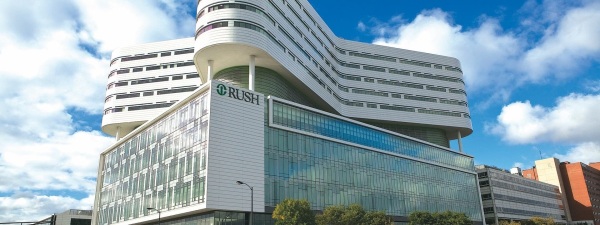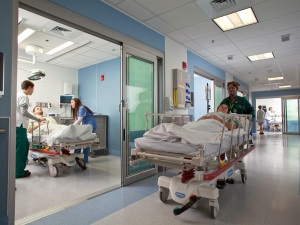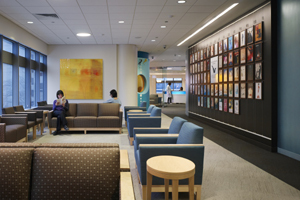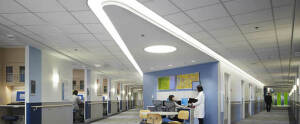Taking a data-driven approach to healthcare in Chicago
December 11, 2020
by Sean Ruck, Contributing Editor
HealthCare Business News recently spoke with Vanessa Roshell-Stacks, former vice president of care coordination, clinical documentation and hospital operations at Rush University Medical Center. She told us about her background and the importance of bringing value to the community across the continuum of care.
HCB News: Who or what inspired you to follow a career in healthcare?
Vanessa Roshell-Stacks: I started off wanting to be a physician. As I got older, in college, I recognized I could still be in the healthcare space but not necessarily be a provider. I had skills that would still allow me to be in healthcare and be there for people. I’m a huge people person, but not providing direct care.
I was first introduced to healthcare as a child because I was a sickly kid and spent a lot of time in the hospital. I was intrigued by the healthcare environment — the nurses and physicians, and everything that surrounded that.
I have an undergraduate degree in experimental psychology and business and actually started out doing behavior modification for autistic children. Then I got my masters and got more into healthcare administration and finance, then into healthcare operations. I absolutely love it.
HCB News: Can you describe the leadership environment at Rush?
VR-S: The leadership environment is very collaborative. It’s a bottom-up culture in the sense that, we have a saying here, “flipping the pyramid.” It means that the voices of our front line heroes are heard. It’s not a culture where things are being dictated to the front line. The voice of our front line staff is valued and appreciated and helps inform how we approach our work each day. That is something that is a testament to the leadership team.
Another important piece is that we have really smart leaders and we have strong clinicians. It’s a very clinically-driven organization in the sense that we have strong clinicians at the top that see and value the importance of the bedside clinician and the impact it has on patient care. The leadership team at Rush values our position in the community, being engaged in the community as well. We place extreme importance in the community benefit we bring to the west side of Chicago.
The use of data is also very important to the leadership team. It helps to drive change and process improvement based on data and not anecdote. We spend a tremendous amount of time with our patients and use data to be able to improve upon the care that we deliver to patients. It’s an analytically-driven culture in the sense that we want to make sure we’re providing the best care to our patients as possible, and if we see opportunities we face them head on and we address that.
HCB News: Can we go into the partnership with CipherHealth when you’re talking about analytics? How has that partnership helped and how has focusing on analytics helped, especially since the pandemic?
VR-S: Our culture is focused so much on using data to drive care and that has really fostered our relationship with Cipher. The partnership with Cipher allows us great intel from the voice of the customer. It's what we think we’re doing and it's what the customer is receiving. The work that we've done for outreach to our patients — whether that be our post discharge calls, and using their feedback from the calls to drive our process redesign within the hospital — has been really important and has helped us reduce our readmission rate which is something we’re very focused on. But also during the COVID crisis, we have continued the outreach calls but expanded more longitudinally to follow the patients post-discharge 14 days to understand what their experience has been, where there are opportunities for us to improve our transitions of care, where there are gaps in the community (ability to receive medications, transportation back to facilities, inability to engage on virtual visits) all of those types of things. That data we’re getting back helps inform us so we can address those needs head on. I think the Cipher partnership has really helped to facilitate a lot of that work
HCB News: Was that focus on analytics and that outreach to patients already well in place before Covid came up?
VR-S: Absolutely — for the years I’ve been there and before I arrived, that work around readmission reduction and outreach was something already embedded in the culture. What the Cipher platform has allowed us to do is scale that work.
Trying to do outreach to discharge patients is resource-intensive and hard to standardize; the automation that came from that software allowed us to scale it, focus on patients who really had needs (we call it escalation). So depending on how patients answer calls will allow our team to reach back out to the patients as a live call and really understand those needs pretty immediately. Without the platform, it's very difficult to do that when you're trying to call the volume of patients that are entering our facilities each day.
HCB News: Can you give some details as to what your patient population is, if it tilts toward an age range, if it tilts toward a type of population?
VR-S: I’ll speak specifically about our medical population since our surgical population is a little different. We have a high-acuity medical population. We are on the west side of Chicago, we get patients of all stripes and certainly we get patients who, from a health perspective, tend to have a lot of comorbidities and tend to have a lack of healthcare literacy. We definitely get a large portion of patients with a lot of chronic diseases — COPD, diabetes, you name it. That is a large portion of our population. Over 50 percent of our medical population are people of color, coming from a lot of what we call “safety net areas” of the city, particularly on the west side.
Our median age I’d suspect is over 50, definitely. Our payor mix is a lot of Medicare and Medicaid, again, for our medical population. It is a demographic of patient of which there’s a lot of medical need, a lot of social need. Many of our patients come from environments where there are a lot of social determinants impacting health — food insecurity, transportation to facilities. As an organization, we have to meet the medical and social needs of the patients, which is what Rush does a great job at. We’re on the frontline of marrying those two: we provide exceptional medical care but we understand their social conditions as well. If you really want to improve the health of the community, you can't turn your back on those other things that impact their health.
HCB News: Can we get into some of the social determinants and what Rush is doing to help to address those needs?
VR-S: We are very involved in west side collaborative. We work closely with our community partners as it relates to supporting our patients and providing shelters for the homeless. For example, we do a lot of work in the community organizations around food and security. We’ve partnered with organizations that provide transportation needs that allow patients to go back and forth for appointments. We have care coordinators and care managers who are in the community helping to support patients and coordinate their care, and navigate patients to ensure they’re getting their follow up appointments. We focus on transitions and making sure that once patients leave our walls, they’re not lost. It’s really a lot of working with agencies in the community whose missions align with the work that Rush is doing. We see patients regardless of their ability to pay. In many respects, Rush is like a safety net in the sense we don’t turn them away if they can't pay, we provide them the care they need.
HCB News: There's been the push to transfer from fee-for-service to value-based care. How has Rush been doing with that?
VR-S: Our team has focused on bringing value across the continuum of care — this is even continuing to happen during COVID. Obviously, during the midst of the surge we weren't talking specifically around value-based care, but as things have stabilized, it’s been back to the forefront again. There is definitely a focus on value-based care — not just the hospital, but once we move into the community as well, how do we continue to bring value to our patients?
We use the data from our analytics team to see where there continue to be opportunities so we can address them head on; whether that be readmissions, access to primary care, making sure patients are following up, et cetera. We know value-based care is coming and so we are well on our way to positioning the organization to align us to have processes in place.
One piece I'm most proud of: the coordination with our post discharge providers. We’re looking at the in-patient care and also what happens when we they’re home, ensuring we’re providing high quality of care. We work very closely with the community to look at this and make sure their quality of care is good. We don't only focus on what's happening in the walls of Rush. We’re looking at the entire patient journey.
HCB News: Communities of color have been hit harder by the pandemic. Was that the case for Rush?
VR-S: I think that’s absolutely true; we did see a higher percentage of those patients who were COVID-positive in-house. It’s very consistent with what other communities have stated. What I’m proud of, is that because we had the connections with the community, it helped us in terms of when patients were recovering and transitioning out, we had those strong connections and processes in place in terms of transitions and care and we knew how to work with those communities.
HCB News: How do you predict healthcare may change due to the lessons learned during the pandemic?
VR-S: I think the use of technology will definitely change moving forward. There’s been reticence for some providers in terms of virtual care. Those days are gone. Another thing COVID has spurred is innovation. How you engage with patients, how waiting rooms are used, ambulatory care, all that will be changed. It's going to transform how we engage with our patients and even with our patients’ families.
HCB News: Who or what inspired you to follow a career in healthcare?
Vanessa Roshell-Stacks: I started off wanting to be a physician. As I got older, in college, I recognized I could still be in the healthcare space but not necessarily be a provider. I had skills that would still allow me to be in healthcare and be there for people. I’m a huge people person, but not providing direct care.
I was first introduced to healthcare as a child because I was a sickly kid and spent a lot of time in the hospital. I was intrigued by the healthcare environment — the nurses and physicians, and everything that surrounded that.
I have an undergraduate degree in experimental psychology and business and actually started out doing behavior modification for autistic children. Then I got my masters and got more into healthcare administration and finance, then into healthcare operations. I absolutely love it.
HCB News: Can you describe the leadership environment at Rush?
VR-S: The leadership environment is very collaborative. It’s a bottom-up culture in the sense that, we have a saying here, “flipping the pyramid.” It means that the voices of our front line heroes are heard. It’s not a culture where things are being dictated to the front line. The voice of our front line staff is valued and appreciated and helps inform how we approach our work each day. That is something that is a testament to the leadership team.
Another important piece is that we have really smart leaders and we have strong clinicians. It’s a very clinically-driven organization in the sense that we have strong clinicians at the top that see and value the importance of the bedside clinician and the impact it has on patient care. The leadership team at Rush values our position in the community, being engaged in the community as well. We place extreme importance in the community benefit we bring to the west side of Chicago.
The use of data is also very important to the leadership team. It helps to drive change and process improvement based on data and not anecdote. We spend a tremendous amount of time with our patients and use data to be able to improve upon the care that we deliver to patients. It’s an analytically-driven culture in the sense that we want to make sure we’re providing the best care to our patients as possible, and if we see opportunities we face them head on and we address that.
HCB News: Can we go into the partnership with CipherHealth when you’re talking about analytics? How has that partnership helped and how has focusing on analytics helped, especially since the pandemic?
VR-S: Our culture is focused so much on using data to drive care and that has really fostered our relationship with Cipher. The partnership with Cipher allows us great intel from the voice of the customer. It's what we think we’re doing and it's what the customer is receiving. The work that we've done for outreach to our patients — whether that be our post discharge calls, and using their feedback from the calls to drive our process redesign within the hospital — has been really important and has helped us reduce our readmission rate which is something we’re very focused on. But also during the COVID crisis, we have continued the outreach calls but expanded more longitudinally to follow the patients post-discharge 14 days to understand what their experience has been, where there are opportunities for us to improve our transitions of care, where there are gaps in the community (ability to receive medications, transportation back to facilities, inability to engage on virtual visits) all of those types of things. That data we’re getting back helps inform us so we can address those needs head on. I think the Cipher partnership has really helped to facilitate a lot of that work
HCB News: Was that focus on analytics and that outreach to patients already well in place before Covid came up?
VR-S: Absolutely — for the years I’ve been there and before I arrived, that work around readmission reduction and outreach was something already embedded in the culture. What the Cipher platform has allowed us to do is scale that work.
Trying to do outreach to discharge patients is resource-intensive and hard to standardize; the automation that came from that software allowed us to scale it, focus on patients who really had needs (we call it escalation). So depending on how patients answer calls will allow our team to reach back out to the patients as a live call and really understand those needs pretty immediately. Without the platform, it's very difficult to do that when you're trying to call the volume of patients that are entering our facilities each day.
HCB News: Can you give some details as to what your patient population is, if it tilts toward an age range, if it tilts toward a type of population?
VR-S: I’ll speak specifically about our medical population since our surgical population is a little different. We have a high-acuity medical population. We are on the west side of Chicago, we get patients of all stripes and certainly we get patients who, from a health perspective, tend to have a lot of comorbidities and tend to have a lack of healthcare literacy. We definitely get a large portion of patients with a lot of chronic diseases — COPD, diabetes, you name it. That is a large portion of our population. Over 50 percent of our medical population are people of color, coming from a lot of what we call “safety net areas” of the city, particularly on the west side.
Our median age I’d suspect is over 50, definitely. Our payor mix is a lot of Medicare and Medicaid, again, for our medical population. It is a demographic of patient of which there’s a lot of medical need, a lot of social need. Many of our patients come from environments where there are a lot of social determinants impacting health — food insecurity, transportation to facilities. As an organization, we have to meet the medical and social needs of the patients, which is what Rush does a great job at. We’re on the frontline of marrying those two: we provide exceptional medical care but we understand their social conditions as well. If you really want to improve the health of the community, you can't turn your back on those other things that impact their health.
HCB News: Can we get into some of the social determinants and what Rush is doing to help to address those needs?
VR-S: We are very involved in west side collaborative. We work closely with our community partners as it relates to supporting our patients and providing shelters for the homeless. For example, we do a lot of work in the community organizations around food and security. We’ve partnered with organizations that provide transportation needs that allow patients to go back and forth for appointments. We have care coordinators and care managers who are in the community helping to support patients and coordinate their care, and navigate patients to ensure they’re getting their follow up appointments. We focus on transitions and making sure that once patients leave our walls, they’re not lost. It’s really a lot of working with agencies in the community whose missions align with the work that Rush is doing. We see patients regardless of their ability to pay. In many respects, Rush is like a safety net in the sense we don’t turn them away if they can't pay, we provide them the care they need.
HCB News: There's been the push to transfer from fee-for-service to value-based care. How has Rush been doing with that?
VR-S: Our team has focused on bringing value across the continuum of care — this is even continuing to happen during COVID. Obviously, during the midst of the surge we weren't talking specifically around value-based care, but as things have stabilized, it’s been back to the forefront again. There is definitely a focus on value-based care — not just the hospital, but once we move into the community as well, how do we continue to bring value to our patients?
We use the data from our analytics team to see where there continue to be opportunities so we can address them head on; whether that be readmissions, access to primary care, making sure patients are following up, et cetera. We know value-based care is coming and so we are well on our way to positioning the organization to align us to have processes in place.
One piece I'm most proud of: the coordination with our post discharge providers. We’re looking at the in-patient care and also what happens when we they’re home, ensuring we’re providing high quality of care. We work very closely with the community to look at this and make sure their quality of care is good. We don't only focus on what's happening in the walls of Rush. We’re looking at the entire patient journey.
HCB News: Communities of color have been hit harder by the pandemic. Was that the case for Rush?
VR-S: I think that’s absolutely true; we did see a higher percentage of those patients who were COVID-positive in-house. It’s very consistent with what other communities have stated. What I’m proud of, is that because we had the connections with the community, it helped us in terms of when patients were recovering and transitioning out, we had those strong connections and processes in place in terms of transitions and care and we knew how to work with those communities.
HCB News: How do you predict healthcare may change due to the lessons learned during the pandemic?
VR-S: I think the use of technology will definitely change moving forward. There’s been reticence for some providers in terms of virtual care. Those days are gone. Another thing COVID has spurred is innovation. How you engage with patients, how waiting rooms are used, ambulatory care, all that will be changed. It's going to transform how we engage with our patients and even with our patients’ families.






